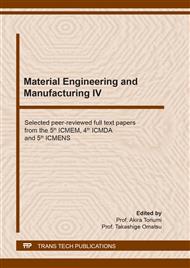p.72
p.81
p.87
p.94
p.103
p.109
p.116
p.125
p.133
Optical Absorption and Photoconversion Characteristics of WO3 Nanofiber Photoanodes Prepared by Electrospinning with Different Calcination Temperatures
Abstract:
This study aims to synthesize and examine the optical and photoelectrochemical properties of tungsten oxide (WO3) nanofibers prepared by electrospinning and calcination using different temperatures (500, 700, and 900 °C). The electrospinning solution contained a mixture of polyvinyl alcohol (PVA, 7.5% w/v) and ammonium metatungstate hydrate (AMH, 16.7% w/v). The morphology of WO3 nanofibers was observed via scanning electron microscopy (SEM) and transmission electron microscopy (TEM). The absorbance of calcined WO3 nanofibers was measured, and the data was used to calculate the optical band gap energy (Eg) through Tauc’s relation. The of calcined WO3 nanofibers were found to be from 2.85 to 3.08 eV. The minimum value of was obtained from the sample calcined at 900 °C. Linear sweep voltammetry (LSV) was employed in the photocurrent measurements under simulated AM 1.5G at 100 mW/cm2 irradiance. The WO3 nanofiber photoanode calcined at 900 °C exhibited the maximum photoconversion efficiency (PCE) of 1.53%, a twice enhancement in PCE compared with those obtained from WO3 nanofibers calcined at lower temperatures. This study suggests the potential pathway for the optimal synthesis of high performance nanostructured metal oxide electrodes for photoelectrochemical water splitting.
Info:
Periodical:
Pages:
103-108
Citation:
Online since:
September 2021
Price:
Сopyright:
© 2021 Trans Tech Publications Ltd. All Rights Reserved
Share:
Citation:


